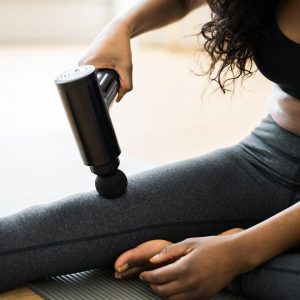The Benefits of Massage Guns

Like a traditional massage, massage guns can relax muscles, increase blood flow, and shorten recovery times, making them increasingly popular. But how do they work, and how can you maximize the benefits of a massage gun?
Orlin & Cohen’s Dr. Lewis Lupowitz, a fellowship-trained sports physical therapist, explains the science behind massage guns, their benefits, and how to incorporate them into a physical therapy program.
Massage gun science: Do they really work?
As a physical therapist, I’ve witnessed the increased use and popularity of portable massage guns firsthand. I see them almost everywhere, at the sidelines of sporting events, gyms, rehab centers, and more.
Still, for many unfamiliar with these massage therapy tools, the question remains: Do massage guns actually work? The simple answer is yes, they do, but I’ll explain the science behind them.
When appropriately used, massage guns deliver both percussion and vibration therapy. Here’s how each works:
- Percussion therapy is a type of massage technique. It delivers strong pulses into the skin, muscles, and joints, stimulating our nervous system’s spinothalamic tract—a neural pathway responsible for transmitting pain, temperature, and touch.
- Vibration therapy provides sensory input to the skin, muscles, and joints via the dorsal column neural pathway, responsible for fine touch and two-point discrimination.
When pairing these therapeutic approaches together in a massage gun, scientific studies have shown that patients experience many benefits, including:
- Pain relief
- Improved blood flow
- Increased tissue temperature
- Increased flexibility
- Increased nitric oxide production (essential for healthy blood vessels)
- Promotion of new bone formation
- Increased muscle strength
- Reduced muscle soreness
How to use a massage gun
Depending on the massage gun you or your therapist uses, different settings are designed to provide different outcomes. Generally, a lower frequency (or beat speed) promotes relaxation and pain relief, while higher frequencies stimulate the nervous system and muscular tissue for quicker recoveries and improved performance. Understanding this allows therapists—and you—to know which setting to use and when to use it to achieve a specific outcome.
In my practice, I use massage guns for three primary reasons: pain relief, increased strength, and reduced muscle soreness via improved blood flow. I’ll explain my experiences with each:
Using massage guns for pain relief
In 2015, I performed a prospective randomized, double-blind study in individuals following arthroscopic rotator cuff repair. They applied 80-Hz of vibration, five minutes per day for six months following the operation. At their six-week follow-up, patients rated their pain significantly lower than patients who had not used the massage gun—demonstrating the tool’s ability to reduce pain and promote relaxation.
To reduce your pain with a massage gun, you can use the device to target tense or tight muscles. Start with a low frequency and apply the massage gun to the area for two minutes at a time.
Increasing strength with massage gun therapy
According to a study, patients using a massage gun at a higher frequency and increased amplitude (or depth of muscle penetration) experienced improved postural stability, the strength needed to control movement and balance.
Benefits were experienced within one day of treatment—highlighting the effectiveness of massage guns in stimulating muscle growth to improve strength.
Using a massage gun to reduce muscle soreness
Massage guns are particularly beneficial when used after exercise. In this study, patients who used massage guns following workouts experienced relaxation and reduced soreness. Interestingly, researchers even saw changes to participants’ blood composition—including decreased interleukin 6, histamine and lymphocytes, and increased neutrophils—all of which signals a reduction in systemic inflammation.
To improve blood flow and reduce muscle soreness after exercise, I use massage guns to treat patients at particularly low frequencies—which has the added benefit of relaxation. Using a massage gun in this capacity also reduces the potential for delayed onset muscle soreness (DOMS), or the muscle stiffness that follows strenuous exercises—so patients can recover from workouts faster.
Massage guns and physical therapy
From reducing stress to enhancing athletic performance, there are many benefits to using a massage gun. But, as always, when incorporating a new tool into your fitness routine, be sure to listen to your body. If you’re experiencing pain or you’re unsure if a massage gun is right for you, consult a medical professional first.
At Orlin & Cohen, our team of licensed physical therapists can determine what types of physical therapy are best for you—including massage gun therapy and other treatments that can relieve pain and help you reach your goals. Request an appointment.



